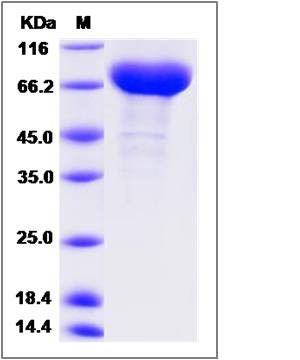Cynomolgus Transferrin Receptor / TFRC / CD71 Protein (His Tag)
TFRC, Tfrc
- 100ug (NPP1689) Please inquiry
| Catalog Number | P90253-C07H |
|---|---|
| Organism Species | Cynomolgus |
| Host | Human Cells |
| Synonyms | TFRC, Tfrc |
| Molecular Weight | The recombinant cynomolgus TFRC comprises 692 amino acids and has a calculated molecular mass of 77.6 KDa. The apparent molecular mass of it is approximately 65-85 KDa in SDS-PAGE under reducing conditions. |
| predicted N | His |
| SDS-PAGE |  |
| Purity | > 95 % as determined by SDS-PAGE |
| Protein Construction | A DNA sequence encoding the cynomolgus TFRC (NP_001244232.1) (Cys89-Phe760) was expressed with a polyhistidine tag at the N-terminus. |
| Bio-activity | Measured by its ability to neutralize transferrin-mediated effect on proliferation of MCF-7 cells. The ED50 for this effect is typically 2-10 μg/mL. |
| Research Area | Cardiovascular |Blood |Serum Protein |
| Formulation | Lyophilized from sterile PBS, pH 7.4. 1. Normally 5 % - 8 % trehalose and mannitol are added as protectants before lyophilization. Specific concentrations are included in the hardcopy of COA. |
| Background | Mouse transferrin receptor protein 1, also known as transferrin receptor, Trfr, p90, CD71 and TFRC, is a single-pass type II membrane protein which belongs to the peptidase M28 family and M28B subfamily. TFRC / CD71 is a membrane-bound protein expressed in larger amounts in proliferating. The specific expression of TFRC can represent a diagnostic tool or a therapeutic target in solid tumours expressing this antigen. Transferrin receptor is necessary for development of erythrocytes and the nervous system. TFRC / CD71 is regulated by cellular iron levels through binding of the iron regulatory proteins, IRP1 and IRP2, to iron-responsive elements in the 3'-UTR. Up-regulated upon mitogenic stimulation. TFRC / CD71 represents a marker of malignant transformation in the pancreas that could be applied as potential diagnostic and therapeutic target. |
| Reference |
